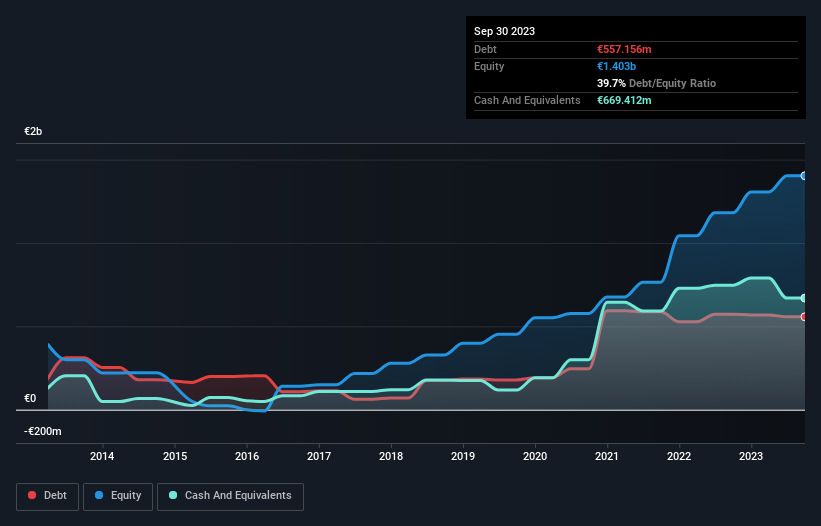David Iben put it well when he said, 'Volatility is not a risk we care about. What we care about is avoiding the permanent loss of capital.' When we think about how risky a company is, we always like to look at its use of debt, since debt overload can lead to ruin. Importantly, Soitec SA (EPA:SOI) does carry debt. But is this debt a concern to shareholders?
When Is Debt A Problem?
Debt assists a business until the business has trouble paying it off, either with new capital or with free cash flow. Ultimately, if the company can't fulfill its legal obligations to repay debt, shareholders could walk away with nothing. However, a more common (but still painful) scenario is that it has to raise new equity capital at a low price, thus permanently diluting shareholders. Of course, debt can be an important tool in businesses, particularly capital heavy businesses. When we examine debt levels, we first consider both cash and debt levels, together.
View our latest analysis for Soitec
How Much Debt Does Soitec Carry?
The chart below, which you can click on for greater detail, shows that Soitec had €557.2m in debt in September 2023; about the same as the year before. However, its balance sheet shows it holds €669.4m in cash, so it actually has €112.3m net cash.

How Strong Is Soitec's Balance Sheet?
We can see from the most recent balance sheet that Soitec had liabilities of €351.8m falling due within a year, and liabilities of €683.8m due beyond that. Offsetting this, it had €669.4m in cash and €321.8m in receivables that were due within 12 months. So it has liabilities totalling €44.4m more than its cash and near-term receivables, combined.
Having regard to Soitec's size, it seems that its liquid assets are well balanced with its total liabilities. So while it's hard to imagine that the €4.66b company is struggling for cash, we still think it's worth monitoring its balance sheet. While it does have liabilities worth noting, Soitec also has more cash than debt, so we're pretty confident it can manage its debt safely.
The good news is that Soitec has increased its EBIT by 6.3% over twelve months, which should ease any concerns about debt repayment. The balance sheet is clearly the area to focus on when you are analysing debt. But it is future earnings, more than anything, that will determine Soitec's ability to maintain a healthy balance sheet going forward. So if you want to see what the professionals think, you might find this free report on analyst profit forecasts to be interesting.
Finally, while the tax-man may adore accounting profits, lenders only accept cold hard cash. While Soitec has net cash on its balance sheet, it's still worth taking a look at its ability to convert earnings before interest and tax (EBIT) to free cash flow, to help us understand how quickly it is building (or eroding) that cash balance. Over the last three years, Soitec recorded negative free cash flow, in total. Debt is usually more expensive, and almost always more risky in the hands of a company with negative free cash flow. Shareholders ought to hope for an improvement.
Summing Up
We could understand if investors are concerned about Soitec's liabilities, but we can be reassured by the fact it has has net cash of €112.3m. And it also grew its EBIT by 6.3% over the last year. So we are not troubled with Soitec's debt use. When analysing debt levels, the balance sheet is the obvious place to start. However, not all investment risk resides within the balance sheet - far from it. For example, we've discovered 1 warning sign for Soitec that you should be aware of before investing here.
Of course, if you're the type of investor who prefers buying stocks without the burden of debt, then don't hesitate to discover our exclusive list of net cash growth stocks, today.
New: Manage All Your Stock Portfolios in One Place
We've created the ultimate portfolio companion for stock investors, and it's free.
• Connect an unlimited number of Portfolios and see your total in one currency
• Be alerted to new Warning Signs or Risks via email or mobile
• Track the Fair Value of your stocks
Have feedback on this article? Concerned about the content? Get in touch with us directly. Alternatively, email editorial-team (at) simplywallst.com.
This article by Simply Wall St is general in nature. We provide commentary based on historical data and analyst forecasts only using an unbiased methodology and our articles are not intended to be financial advice. It does not constitute a recommendation to buy or sell any stock, and does not take account of your objectives, or your financial situation. We aim to bring you long-term focused analysis driven by fundamental data. Note that our analysis may not factor in the latest price-sensitive company announcements or qualitative material. Simply Wall St has no position in any stocks mentioned.
About ENXTPA:SOI
Soitec
Develops and manufactures semiconductor materials in Asia, Europe, and the United States.
Reasonable growth potential with adequate balance sheet.
Similar Companies
Market Insights
Community Narratives


Recently Updated Narratives

CoreWeave's Revenue Expected to Rocket 77.88% in 5-Year Forecast

Bisalloy Steel Group will shine with a projected profit margin increase of 12.8%

Astor Enerji will surge with a fair value of $140.43 in the next 3 years
Popular Narratives


MicroVision will explode future revenue by 380.37% with a vision towards success


NVDA: Expanding AI Demand Will Drive Major Data Center Investments Through 2026



